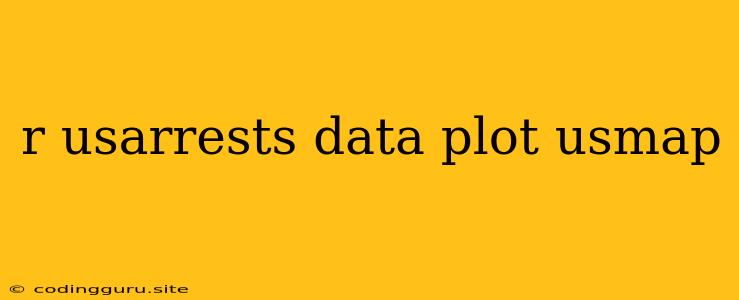Exploring US Arrests Data: A Visual Journey with the USmap Package
The r usarrests dataset is a built-in dataset in R that contains data on arrests per 100,000 residents for different types of crimes across various US states. This dataset can be used for various statistical analyses, but it's particularly insightful to visualize the data using maps. This is where the usmap package comes into play.
Why visualize with USmap?
Simply looking at raw numbers in a table doesn't provide a clear understanding of the geographical distribution of arrests. Using usmap, we can create visually compelling maps that highlight the spatial patterns of crime rates across the United States. This allows us to identify trends, compare states, and potentially understand the underlying factors contributing to variations in arrest rates.
Getting started: Installing and loading necessary packages
-
Install the usmap package: If you don't have it installed, run the following command in your R console:
install.packages("usmap") -
Load the usmap package:
library(usmap) -
Load the r usarrests dataset:
data(USArrests)
Creating basic US maps with arrest data
-
Plotting a single variable:
Let's start with a simple map showing the Murder arrest rates across the US:
plot_usmap(data = USArrests, values = "Murder", color = "blue") + labs(title = "Murder Arrests per 100,000 Residents")This code generates a map where states with higher murder arrest rates are shaded darker blue.
-
Customizing the map:
The usmap package offers a plethora of customization options. You can adjust:
- Color palette: Use the
colorargument to change the color scale. - Title: Use the
titleargument withinlabs()to give your map a descriptive title. - Legend: Use the
legendargument to adjust the legend's appearance. - Labels: Use the
include_statesandlabelsarguments to add state names or abbreviations to the map.
For example, to create a map with a red color scale and state labels:
plot_usmap(data = USArrests, values = "Murder", color = "red") + labs(title = "Murder Arrests per 100,000 Residents") + theme(legend.position = "right") + usmap::usmap_labels(state_names = TRUE, label_color = "black") - Color palette: Use the
Exploring multiple variables with USmap
-
Creating separate maps:
To visualize multiple variables like Assault, Rape, and Murder, you can simply create separate maps for each variable, using the code provided in the previous examples, but changing the
valuesargument accordingly. -
Combining variables with facetting:
To compare the spatial distribution of different variables directly, you can use facetting. This allows you to display multiple maps side-by-side, each representing a different variable.
library(ggplot2) ggplot(USArrests, aes(map_id = state, fill = Murder)) + geom_map(map = usmap::us_map, color = "white") + facet_wrap(~ variable, nrow = 2) + labs(title = "Arrest Rates by Crime Type") + theme(legend.position = "right")This code creates a map with four facets, one for each variable in the
USArrestsdataset: Murder, Assault, Rape, and Robbery.
Analyzing spatial patterns and correlations
By visually exploring the r usarrests data with usmap, you can:
- Identify clusters: Are there regions of the US with significantly higher or lower arrest rates for specific crimes?
- Compare states: How do the arrest rates for different crimes vary between neighboring states?
- Explore potential correlations: Are there relationships between arrest rates for different crime types? For example, do states with high murder rates also tend to have high assault rates?
Further Exploration and Tips
- Data transformation: You can experiment with data transformations (like taking logarithms) to better visualize the differences in arrest rates, especially if the data is highly skewed.
- Filtering data: You can filter the data to focus on specific regions or crimes. For example, you might want to create a map showing arrest rates for assault only in the southern states.
- Interactive maps: For more dynamic exploration, consider using interactive map libraries like Leaflet or Mapbox.
Conclusion
The combination of the r usarrests dataset and the usmap package provides a powerful tool for visually exploring crime trends across the United States. By creating insightful maps and analyzing the spatial patterns, we can gain a deeper understanding of the factors that contribute to variations in arrest rates and potentially inform policy decisions.
